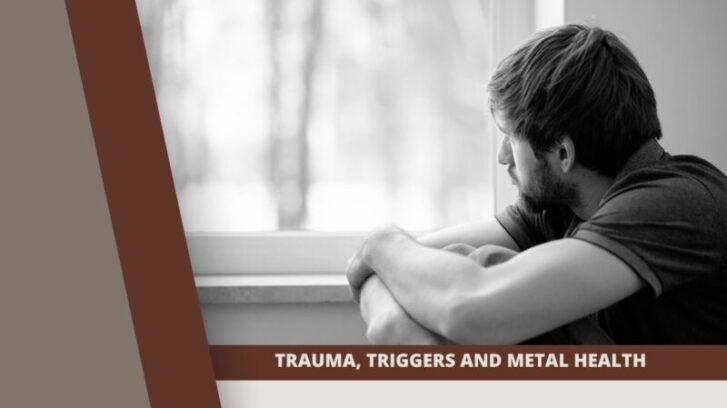Trauma is a deeply distressing and overwhelming experience that has profound effects on a person’s mental health. It can stem from various sources such as abuse, violence, accidents, natural disasters, or other life-altering events.
The impact of can be long-lasting, affecting an individual’s emotional, psychological, and physical well-being. To navigate the complex journey of recovery, it is crucial to understand the role of triggers – the stimuli that elicit traumatic reactions – and how they are interconnected with mental health.
In this article, we delve into the intricacies of trauma, triggers, and mental health, providing insights, coping strategies, and pathways to healing.
It encompasses a wide range of experiences that can be categorized into different forms: acute, chronic, complex, and developmental. Acute occurs as a result of a single traumatic event, such as a car accident or physical assault. Chronic refers to repeated exposure to distressing events, such as ongoing abuse or warfare.
Complex relates to multiple incidents occurring within a relational context, often associated with childhood abuse or neglect. Lastly, development occurs during critical stages of growth and can have long-lasting effects on a person’s development.
The causes of trauma are multifaceted and can vary from person to person. They may include interpersonal violence, accidents, natural disasters, war, and systemic oppression. When an individual experiences , it affects both their psychological and physiological well-being.
On a psychological level, trauma can lead to symptoms such as flashbacks, nightmares, intrusive thoughts, anxiety, depression, and difficulty concentrating. Physiologically, it triggers the body’s stress response system, resulting in heightened arousal, increased heart rate, and other physical manifestations of distress.
Trauma and Mental Health
The relationship between trauma and mental health disorders is significant. Research has shown that individuals who have experienced it are more susceptible to developing mental health conditions, such as post-traumatic stress disorder (PTSD), depression, anxiety disorders, substance abuse disorders, and dissociative disorders.
It can have a profound impact on brain functioning, particularly in areas responsible for memory, emotional regulation, and the stress response system. These alterations in brain activity can contribute to the development of mental health disorders and make it challenging for individuals to cope with daily life stressors.
The long-term consequences cannot be underestimated. Traumatic experiences can shape an individual’s worldview, eroding their sense of safety and trust in others. Unresolved trauma can lead to chronic emotional dysregulation, difficulties in forming and maintaining relationships, self-destructive behaviors, and a diminished sense of self-worth. Consequently, the impact extends beyond the initial event and can significantly impede an individual’s quality of life.
Identifying Triggers
Triggers play a crucial role in recovery. They are external or internal stimuli that evoke distressing emotions, memories, or physical sensations associated with the traumatic event.
They can vary from person to person and can encompass a wide range of sensory experiences, such as sights, sounds, smells, tastes, or even specific words or phrases. Identifying triggers is an essential step in understanding and managing trauma reactions effectively.
There are several techniques for identifying triggers. Self-reflection and introspection are valuable tools for recognizing patterns and associations between certain stimuli and distressing reactions. Keeping a journal or diary can help individuals track their emotional and physical responses to different situations and identify recurring triggers.
Seeking professional help from therapists specializing in trauma can provide further guidance in identifying triggers and understanding their underlying causes. By identifying triggers, individuals can gain insight into their trauma responses and take steps towards healing and recovery.
The Role of Triggers
Triggers have the power to reawaken memories, emotions, and physical sensations associated with the traumatic event. When triggered, individuals may experience heightened anxiety, fear, anger, sadness, or a sense of detachment.
These reactions are connected to the body’s stress response system, which activates in response to perceived threats. It triggers can elicit a fight-or-flight response, leading to increased heart rate, rapid breathing, sweating, and muscle tension.
In some cases, triggers can also lead to trauma reenactment, where individuals unconsciously recreate aspects of the traumatic event in their current lives. This phenomenon is thought to be a way for the brain to process and make sense of it.
For example, a person who experienced childhood abuse may find themselves in abusive relationships as adults. Trauma reenactment can be a complex and challenging pattern to break, but with the right support and therapeutic interventions, individuals can work towards healing and developing healthier coping mechanisms.
Coping
Coping mechanisms are essential tools for managing triggers and mitigating the impact on mental health. One effective coping strategy is grounding techniques, which help individuals stay present and connected to the present moment.
These techniques can involve engaging the senses, such as focusing on the feeling of the ground beneath one’s feet or listening to soothing music. Breathing exercises, mindfulness, and meditation can also be valuable in grounding oneself during triggering situations.
Therapeutic interventions play a crucial role in coping with triggers and facilitating recovery. Approaches such as cognitive-behavioral therapy (CBT) can help individuals identify and challenge negative thought patterns and develop healthier coping strategies.
Eye movement desensitization and reprocessing (EMDR) is another evidence-based therapy that focuses on processing traumatic memories and reducing their emotional impact. Additionally, support groups and peer networks provide a safe space for individuals to share their experiences, learn from others, and gain validation and support.
Healing and Recovery
Addressing is a crucial step towards healing and recovery. Trauma-informed care recognizes the impact on individuals and incorporates this understanding into treatment approaches. It emphasizes safety, trust, choice, collaboration, and empowerment.
Creating a informed environment involves training professionals across various fields to recognize the signs of trauma and respond with sensitivity and compassion. By adopting informed practices, healthcare providers, educators, and community leaders can support individuals in their journey of healing.
Building resilience is an essential aspect of recovery. Resilience refers to the ability to bounce back from adversity and adapt to challenging circumstances. While it can have long-lasting effects, resilience can help individuals regain a sense of control, restore their self-esteem, and foster hope.
Building resilience involves developing healthy coping mechanisms, cultivating supportive relationships, setting goals, and engaging in self-care practices. It is a gradual and ongoing process that requires patience, self-compassion, and perseverance.
Finding hope is paramount in the journey of healing. It can shatter an individual’s sense of safety and trust, leaving them feeling hopeless and helpless. However, it is crucial to remember that healing is possible.
With the right support, treatment, and self-care strategies, individuals can reclaim their lives and move forward with renewed strength and purpose. Seeking professional help and reaching out to supportive networks are vital steps in finding hope and embarking on the path to recovery.
Seeking Professional Help
Recognizing when professional help is needed is an essential aspect of recovery. It is common for individuals to hesitate or feel reluctant to seek help due to stigma, shame, or fear.
However, reaching out to mental health professionals can provide invaluable support and guidance. There are various types of mental health professionals who specialize in trauma and can offer evidence-based treatments.
Psychiatrists are medical doctors who can diagnose and prescribe medications to manage trauma-related symptoms and co-occurring mental health disorders. Psychologists, on the other hand, provide therapy and counseling services, utilizing therapeutic approaches such as CBT, EMDR, and psychodynamic therapy. Social workers, counselors, and licensed therapists also play significant roles in recovery, offering individual, group, and family therapy.
Available treatments for trauma include focused therapies, medication management, and complementary approaches such as art therapy, yoga, and mindfulness practices. It is essential to work collaboratively with a mental health professional to determine the most suitable treatment approach based on individual needs and preferences.
Self-Care Strategies
Here are some self-care strategies that can be beneficial for trauma survivors:
- Establishing a self-care routine: Incorporate activities such as exercise, adequate sleep, healthy eating, and relaxation techniques into daily life.
- Engaging in creative outlets: Explore art, music, writing, or any form of creative expression as a way to process emotions and promote self-discovery.
- Practicing mindfulness and meditation: Cultivate present-moment awareness and focus on the breath to reduce stress, increase self-awareness, and promote inner peace.
- Connecting with nature: Spend time outdoors, go for walks, or engage in activities that foster a sense of connection with the natural world.
- Nurturing social connections: Seek support from trusted friends, family members, or support groups. Surround yourself with positive and understanding individuals who can provide a safe space for healing and growth.
- Prioritizing self-compassion and acceptance: Treat yourself with kindness, understanding that healing takes time, and progress may not always be linear. Practice self-acceptance and celebrate small victories along the way.
Self-care is not selfish but rather an essential part of healing and maintaining mental well-being. By nurturing themselves, trauma survivors can replenish their emotional resources and foster a sense of empowerment and self-worth.
Support Systems
Supportive relationships play a vital role in the journey of trauma recovery. Building a safe and reliable support network can provide a sense of belonging, validation, and encouragement.
Friends, family members, and loved ones can offer emotional support, lend a listening ear, and provide practical assistance when needed. It is crucial to communicate one’s needs and boundaries to ensure that the support received is helpful and respectful.
Group therapy and support groups specifically tailored for trauma survivors can be immensely beneficial. These settings offer a space for individuals to share their experiences, learn from others, and gain validation and support.
Being surrounded by people who have gone through similar challenges can foster a sense of community, reduce feelings of isolation, and promote a shared journey of healing.
Online communities and forums can also provide valuable support, particularly for those who may face barriers to in-person support. Connecting with others who have experienced trauma through online platforms allows for anonymous participation and access to a diverse range of perspectives and experiences.
Trauma-Informed Communities
Creating trauma-informed environments is essential for supporting trauma survivors and fostering healing on a broader scale. Trauma-informed communities aim to raise awareness, educate professionals across various fields, and implement practices that prioritize safety, respect, and sensitivity. These communities recognize the prevalence and its impact on individuals, families, and communities.
Educating professionals in sectors such as healthcare, education, social services, and criminal justice is crucial for creating informed communities. Training programs and workshops can provide professionals with the necessary knowledge and skills to recognize symptoms, respond with empathy, and provide appropriate support.
By integrating trauma-informed practices into their work, professionals can minimize the risk of retraumatization and create a safe and healing environment for those they serve.
Additionally, raising public awareness about it and its effects is essential for breaking down stigma and promoting understanding and compassion. Community-wide initiatives, public forums, and educational campaigns can help dispel misconceptions, encourage open conversations, and create a supportive atmosphere for trauma survivors.
Implementing trauma-informed practices in various settings, such as schools, workplaces, healthcare facilities, and community organizations, can significantly contribute to the overall well-being of individuals impacted by trauma. By fostering trauma-informed communities, we can collectively work towards a society that prioritizes healing, resilience, and empowerment.
Compassion Fatigue
While we have discussed the impact of trauma on individuals, it is crucial to acknowledge the toll it can take on professionals and caregivers who work with survivors. Secondary , also known as vicarious trauma, refers to the indirect exposure through hearing or witnessing the experiences of others. Professionals in fields such as mental health, social work, emergency response, and caregiving are particularly susceptible to secondary.
The constant exposure to traumatic stories and the emotional strain of supporting survivors can lead to compassion fatigue.
Compassion fatigue is characterized by physical, emotional, and spiritual exhaustion, reduced empathy, and a sense of overwhelm. It is essential for professionals and caregivers to prioritize self-care and seek support to prevent burnout and maintain their well-being.
Self-care strategies for professionals and caregivers include setting boundaries, engaging in regular self-reflection and supervision, seeking support from colleagues or support groups, and taking breaks when needed.
Organizations and institutions should also prioritize creating a supportive work environment that acknowledges the emotional demands of the profession and offers resources for self-care and stress management.
Cultural Considerations in Trauma
It is crucial to recognize and address cultural considerations when working with survivors. Culture shapes an individual’s beliefs, values, norms, and coping mechanisms. The impact of trauma can be influenced by cultural factors, including cultural beliefs about mental health, societal expectations, and barriers to seeking help.
Cultural competency is essential for providing effective and sensitive care to individuals from diverse backgrounds. It involves understanding and respecting cultural differences, recognizing the role of culture in shaping an individual’s experiences and adapting interventions to meet the specific needs of different cultural groups.
Addressing cultural barriers to accessing mental health services is crucial. This involves promoting culturally appropriate outreach and education, providing language services, and ensuring that mental health professionals are trained in cultural competence.
Collaboration with community leaders, organizations, and cultural institutions can help bridge the gap and provide trauma-informed care that is inclusive and respectful of diverse cultural backgrounds.
Overcoming Stigma and Promoting Advocacy
Breaking the stigma surrounding trauma and mental health is essential for creating an environment that supports healing and recovery. Stigma can prevent individuals from seeking help, sharing their experiences, and accessing necessary support services. Overcoming stigma requires a collective effort involving individuals, communities, and policymakers.
Advocacy plays a crucial role in challenging stigma and advocating for improved access to quality mental health care. By sharing personal stories, engaging in public discussions, and raising awareness, individuals can contribute to reducing the shame and discrimination associated with trauma and mental health disorders.
Policy changes are necessary to ensure that mental health services are accessible, affordable, and integrated into healthcare systems. Advocating for policy reforms that prioritize trauma-informed care, increase funding for mental health services, and improve insurance coverage can have a significant impact on the well-being of survivors.
Final Words
They are complex and interconnected subjects that have a profound impact on individuals’ lives. Understanding trauma and its various forms is crucial for recognizing its effects on mental health and overall well-being. It can lead to a range of mental health disorders and alter brain functioning, causing long-term consequences.
Related Posts:
- Injustice Trauma - Examples, Effects, And Affirming Care
- What's the Connection Between Fear, Trauma, and Anger?
- How Childhood Trauma Affects Us as Adults - Healing…
- Family Support in Mental Health Treatment:…
- Women Mental Health and Anxiety: Breaking the…
- The Role of Humanistic and Existential Therapy in…
















